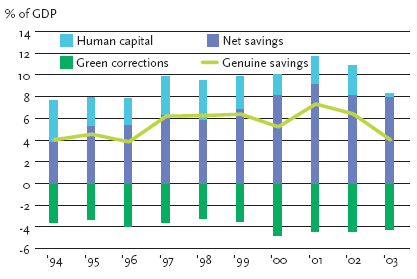|
| Front page | | Contents | | Previous | | Next |
Key indicators 2004
3
Genuine Savings
Source: The Ministry of Finance

"Genuine Savings" is an economic indicator for developments in the total wealth of society. This means that the concept is used to determine the value of economic, social and environmental resources. The
"Genuine Savings" indicator covers the financial net savings (i.e. savings less depreciation) plus savings in terms of human capital (e.g. in the form of training at workplaces), less the use of natural resources
(oil and gas reserves) and the negative effects of emissions of greenhouse gases and a number of pollutants. All of these elements are assigned a monetary value. However, these "green corrections" only
incorporate the effects on nature and environment to which a monetary value can be assigned. This means that a number of effects are not included in the scope of this indicator.
The total wealth of society is increasing
"Genuine Savings" have been positive since 1994, and they have amounted to between 4 and 7 per cent of GDP each year. No calculations for this indicator can be made for before 1994. The main reason
that the green corrections increased in 2000 is primarily the higher price assigned to extraction of oil and gas from the North Sea due to the increases in the price of crude oil. This factor is, however, more or
less cancelled out by increasing economic net savings. The decrease in "Genuine Savings" from 2002 to 2003 is due to a drop in the contribution from savings in human capital as the method of calculating
the workforce statistics has been changed.
The objective is to maintain positive "Genuine Savings", so that the economic net savings and the savings in terms of human capital together exceed the value of the green corrections. The "Genuine Savings"
indicator is still being developed, and it must be supplemented by analyses of what constitutes critical impacts on health, nature, and the environment.
| Front page | | Contents | | Previous | | Next | | Top |
Version 1.0 May 2005, © Danish Environmental Protection Agency
|